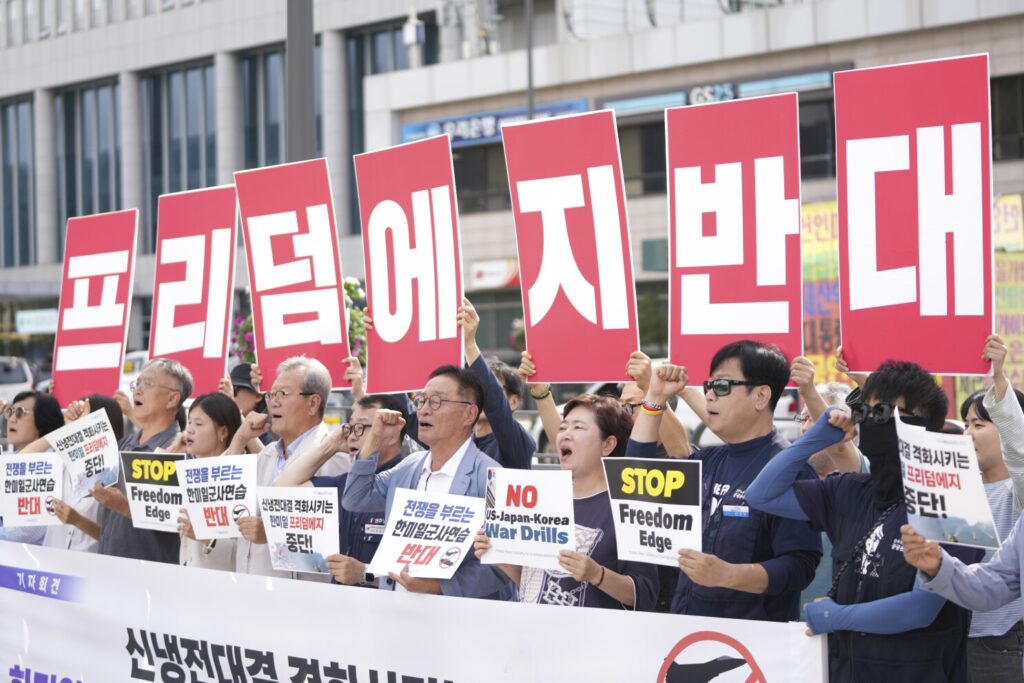In a significant move to strengthen trilateral security cooperation, the United States, South Korea, and Japan have launched the Freedom Edge military exercise in the Indo-Pacific region. This large-scale drill is aimed at improving joint defense capabilities, deterring regional threats, and reinforcing their commitment to a free, open, and secure Indo-Pacific.
The exercise marks another milestone in the deepening defense partnership among the three nations, especially amid rising security challenges in the region, including North Korea’s continued missile tests and China’s growing assertiveness in the South China Sea.
What is the Freedom Edge Military Exercise?
The Freedom Edge exercise is a multi-domain military drill involving naval, air, cyber, and missile defense operations. Unlike traditional bilateral exercises, Freedom Edge brings together three major allies for joint training, enhancing their ability to work seamlessly in a crisis situation.
This year’s exercise includes:
- Joint Naval Drills: Simulating maritime security operations, anti-submarine warfare, and carrier strike group maneuvers.
- Air Operations: Coordinated fighter jet flights, aerial refueling, and air defense exercises.
- Missile Defense Training: Improving detection and interception capabilities against ballistic missile threats.
- Cybersecurity Exercises: Focused on defending critical infrastructure from cyberattacks and enhancing information-sharing networks.
By integrating these components, the Freedom Edge drill represents a comprehensive approach to modern warfare, addressing not just traditional military threats but also emerging challenges like cyber and space security.
Why Freedom Edge Matters

1. Strengthening Trilateral Security Cooperation
The US, South Korea, and Japan have historically worked together in bilateral frameworks, but Freedom Edge symbolizes their growing trilateral partnership. This reflects a shared understanding that collective defense is critical to countering common threats in the region.
2. Deterring North Korea’s Aggression
North Korea’s frequent ballistic missile launches and nuclear ambitions have kept the region on high alert. This exercise sends a strong message to Pyongyang about the allies’ preparedness and ability to respond to any provocation swiftly and jointly.
3. Countering China’s Assertiveness
China’s military build-up and assertive actions in the South and East China Seas are a source of concern for regional stability. Freedom Edge demonstrates that the US, Japan, and South Korea are committed to maintaining freedom of navigation and the rules-based order in the Indo-Pacific.
4. Enhancing Joint Readiness
In an era where modern warfare involves multi-domain operations, exercises like Freedom Edge ensure that forces from different nations can communicate, coordinate, and operate together effectively in real-time scenarios.
The Role of Each Participant
United States
As a leading Indo-Pacific power, the US provides advanced naval assets, aircraft carriers, missile defense systems, and intelligence-sharing platforms. Its participation ensures technological superiority and command-and-control expertise.
South Korea
South Korea brings its highly trained naval and air force units, contributing to anti-submarine warfare, missile tracking, and amphibious operations. For Seoul, the exercise also underscores its alliance commitments and its readiness to defend against North Korean threats.
Japan
Japan plays a vital role in maritime security, surveillance, and logistics. With its advanced Aegis-equipped destroyers and maritime patrol aircraft, Japan enhances the overall missile defense capability of the group.
Economic and Diplomatic Impact
The launch of Freedom Edge is not just a military event; it has diplomatic and economic significance as well.
- Diplomatic Impact: It strengthens trust among the three nations, paving the way for more joint initiatives on technology, cybersecurity, and climate security.
- Economic Stability: A secure Indo-Pacific is crucial for global trade. By ensuring open sea lanes, these exercises contribute to smooth shipping operations, which benefit global supply chains.
Challenges and Criticism
While the exercise is being welcomed by many as a step toward regional stability, some critics argue that it could escalate tensions.
- China’s Reaction: Beijing has consistently opposed such drills, calling them “provocative.” China claims they destabilize the region and threaten its security.
- North Korea’s Response: Pyongyang has condemned trilateral exercises in the past and may respond with more missile tests, raising tensions.
Despite these criticisms, defense experts argue that preparedness and deterrence are essential to prevent miscalculations and maintain peace.
Future of Trilateral Cooperation
The Freedom Edge exercise could become a regular trilateral drill, much like RIMPAC (Rim of the Pacific Exercise), to institutionalize cooperation. The three nations are also exploring ways to expand collaboration in:
- Space Security: Monitoring satellite activities and sharing space intelligence.
- AI and Autonomous Systems: Joint research on military AI applications.
- Supply Chain Security: Protecting critical infrastructure such as semiconductors and energy routes.
Conclusion
The Freedom Edge military exercise marks a turning point in trilateral security cooperation between the US, South Korea, and Japan. It represents a clear message of unity, deterrence, and commitment to maintaining peace and stability in the Indo-Pacific.
As the geopolitical landscape continues to evolve, such collaborative efforts will be essential in shaping a rules-based, secure future for the region. The exercise not only strengthens military readiness but also builds confidence among allies and reassures the international community that the Indo-Pacific remains open and free.

